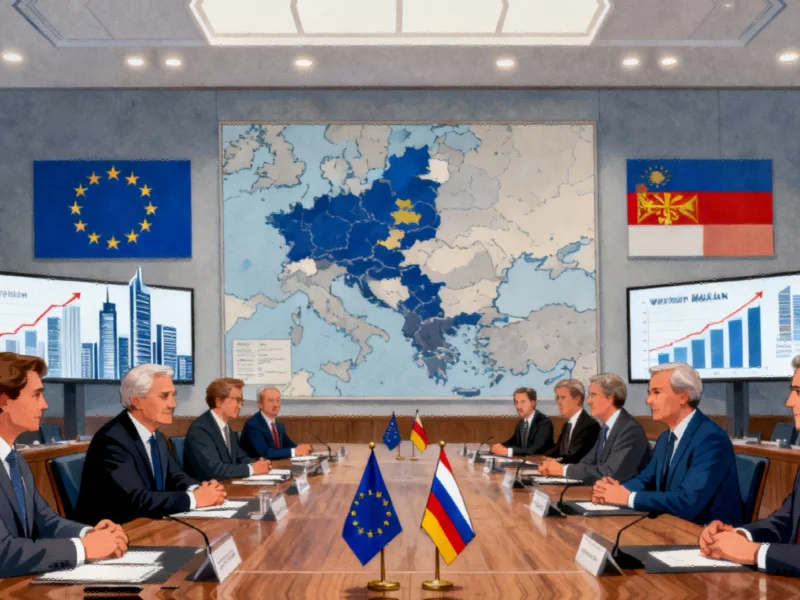Europe’s Strategic Crossroads in the Balkans
As European leaders prepare for the upcoming Western Balkans summit, the region stands at a pivotal moment in its relationship with the European Union. The geopolitical stakes have never been higher, with Russia and China increasingly active in a region that represents Europe’s unfinished business. The EU faces what many analysts describe as a strategic imperative to deepen engagement with these six nations, particularly as global powers compete for influence in this historically volatile area.
The Growth Plan: A New Approach to Integration
The European Commission’s €6 billion “Growth Plan” represents a fundamental shift in how Brussels approaches enlargement. Rather than maintaining the traditional binary of membership versus non-membership, this initiative offers gradual access to the single market as an intermediate step. This innovative approach allows candidate countries to demonstrate their European credentials through practical integration while continuing necessary reforms.
The plan’s focus on economic convergence addresses a critical challenge: at current growth rates, the Western Balkans would need decades to reach EU average income levels. By facilitating earlier access to specific market sectors, particularly digital and financial services, the EU can accelerate development while maintaining reform incentives.
Regional Cooperation as Foundation for Integration
Before joining the EU’s single market of 450 million people, the Western Balkans must first strengthen their own regional market of 18 million. This process has already yielded tangible benefits, including the elimination of roaming charges in 2021—a concrete achievement that demonstrates how regional cooperation delivers immediate value to citizens.
Recent developments in energy and infrastructure mirror the type of integration needed in the Balkans, where connectivity projects could transform economic prospects. The mutual recognition of diplomas, professional qualifications, and identity documents represents another step toward reducing bureaucratic barriers that have long hampered regional development.
Demographic Challenges and Economic Opportunities
The Western Balkans face a looming demographic crisis that threatens to undermine both economic growth and European integration prospects. United Nations projections indicate the region could lose approximately 3 million people—17% of its current population—by 2050 due to low birth rates and high emigration.
This demographic challenge intersects with broader technological transformations reshaping global economies. Without meaningful progress toward EU integration, the region risks losing its most talented young people to member states, creating a vicious cycle of brain drain and economic stagnation.
Geopolitical Dimensions of Balkan Integration
The EU’s engagement with the Western Balkans occurs against a backdrop of intensifying global competition. Both Russia and China have increased their economic and political influence in the region, offering alternative partnerships that don’t require difficult reforms or adherence to democratic standards.
This geopolitical context makes the EU’s approach particularly significant. As recent digital infrastructure developments demonstrate, technological standards and connectivity have become new frontiers in geopolitical competition. The EU’s offer of gradual market integration represents a strategic response to these challenges, providing a European alternative to non-Western investment and influence.
Public Opinion and the Momentum for Change
Recent surveys reveal a region increasingly oriented toward Europe. Support for EU membership has risen to 64%, the highest level in a decade, while optimism about accession timelines grows steadily. This shift in public sentiment reflects both frustration with the status quo and recognition that European integration offers the clearest path to stability and prosperity.
The changing attitudes parallel broader industrial transformations affecting global manufacturing and trade patterns. As automation and digitalization reshape economic landscapes, the Western Balkans cannot afford to remain on the periphery of European markets and innovation ecosystems.
The Path Forward: Concrete Benefits Before Membership
The Berlin Process, initiated by Angela Merkel in 2014, has evolved to focus on delivering tangible benefits long before formal accession. This approach recognizes that citizens need to see improvements in their daily lives—from lower phone bills to easier travel—to maintain support for the difficult reform process.
Current technological advancements in automation and AI could help bridge development gaps more rapidly than previously possible. The key challenge lies in ensuring these innovations benefit the Western Balkans rather than further marginalizing the region.
As leaders prepare to meet again in London, they face both opportunity and responsibility. The success of this renewed engagement will depend on maintaining momentum through concrete achievements while addressing the complex market dynamics that affect investment and growth throughout the region. For Europe, the integration of the Western Balkans represents not just enlargement but the completion of a project that began with the reconciliation of France and Germany after World War II.
A Strategic Imperative for European Security
The ultimate success of EU engagement in the Western Balkans will be measured not just in economic indicators or reform milestones, but in the consolidation of a stable, prosperous European periphery. A integrated Western Balkans means fewer crises exported to member states, reduced opportunities for external manipulation, and a stronger, more cohesive Europe.
This strategic dimension makes current efforts more significant than previous enlargement rounds. In an era of renewed great power competition, the Western Balkans represent both a test of European resolve and an opportunity to demonstrate that the EU remains the region’s primary anchor of stability and prosperity.
This article aggregates information from publicly available sources. All trademarks and copyrights belong to their respective owners.
